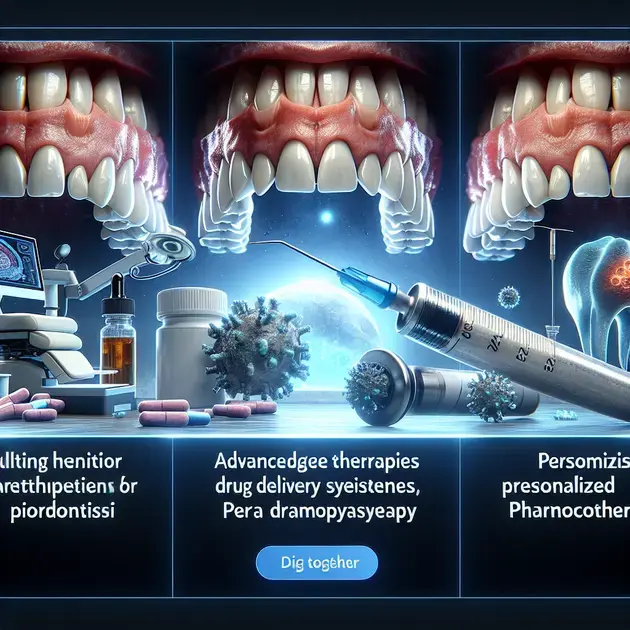Periodontitis can be a challenging condition to manage, but with the right medication, it is possible to effectively treat and control the disease. In this comprehensive guide, we will explore the various medications available for periodontitis and how they can help improve oral health.
From antibiotics to antimicrobial mouth rinses, there are a range of options when it comes to treating periodontitis. Understanding the effectiveness of different medications is crucial in developing a successful treatment plan that targets the root cause of the disease.

Effective Medication Options for Periodontitis
Periodontitis is a severe gum infection that damages the soft tissue and destroys the bone that supports your teeth. Along with professional dental treatment, medication can play a crucial role in managing this condition. Here are some effective medication options for periodontitis:
1. Antibiotics
Antibiotics are commonly prescribed to treat periodontal infections. They work by killing the bacteria causing the infection and reducing inflammation in the gums. One popular antibiotic for periodontitis is doxycycline, which can be taken orally or applied topically in the form of a gel. Consult with your dentist or healthcare provider to determine the most suitable antibiotic for your condition.
2. Antiseptic Mouthwash
Using an antiseptic mouthwash can help reduce the bacterial load in your mouth, promoting healing and preventing further infection. Look for mouthwashes containing chlorhexidine, which is known for its antibacterial properties. Use the mouthwash as directed by your dentist or follow the instructions on the product label for optimal results.
3. Pain Relievers
If you experience pain and discomfort due to periodontitis, over-the-counter pain relievers such as ibuprofen or acetaminophen can provide temporary relief. However, it is essential to address the underlying cause of the pain by seeking professional dental treatment. Follow the recommended dosage instructions and consult your dentist if the pain persists.
4. Prescription Mouth Rinse
In some cases, your dentist may prescribe a specialized mouth rinse containing antimicrobial agents to help control bacterial growth in your mouth. These prescription mouth rinses are stronger than over-the-counter options and can be an effective addition to your oral care routine. Use the prescribed mouth rinse as instructed by your dentist for optimal benefits.
5. Enzyme Suppressants
Enzyme suppressants are medications that inhibit the action of specific enzymes involved in the breakdown of gum tissue. By reducing the activity of these enzymes, enzyme suppressants can help slow down the progression of periodontitis and protect your gums from further damage. Ask your dentist about the possibility of incorporating enzyme suppressants into your treatment plan.
Understanding the Role of Antibiotics in Treatment
Antibiotics are a crucial component of periodontal treatment, helping to combat bacterial infections and support the healing process. Here’s a closer look at the role of antibiotics in treating periodontitis:
1. Targeting Bacterial Infections
Antibiotics target the specific bacteria responsible for periodontal infections, helping to eliminate the infection and reduce inflammation in the gums. By disrupting the bacterial colonies in your mouth, antibiotics can significantly improve the effectiveness of other periodontal treatments, such as scaling and root planing.
2. Preventing Reoccurrence
After completing a course of antibiotics, it is essential to follow up with good oral hygiene practices to prevent the recurrence of periodontal infections. Regular brushing, flossing, and dental check-ups can help maintain a healthy balance of oral bacteria and reduce the risk of future gum disease.
3. Combination Therapy
Often, antibiotics are used in combination with other periodontal treatments to achieve optimal results. Your dentist may recommend a comprehensive treatment plan that includes antibiotics, scaling and root planing, and ongoing maintenance to ensure long-term oral health.
4. Minimizing Side Effects
While antibiotics are effective in treating periodontitis, they can also have side effects such as gastrointestinal upset or allergic reactions. It is crucial to follow your dentist’s instructions carefully, including the prescribed dosage and duration of antibiotic therapy, to minimize the risk of side effects and ensure the best possible outcome.
5. Consultation with Healthcare Provider
Before starting any antibiotic treatment for periodontitis, consult with your dentist or healthcare provider to determine the most appropriate antibiotic and dosage for your condition. Your healthcare provider will consider factors such as your medical history, previous antibiotic use, and the specific bacteria causing your infection to tailor a treatment plan that is safe and effective for you.
Maximizing the Benefits of Antimicrobial Mouth Rinses
Antimicrobial mouth rinses can be a valuable addition to your oral care routine, helping to reduce plaque, fight bacteria, and improve overall gum health. To maximize the benefits of antimicrobial mouth rinses, consider the following tips:
1. Choose the Right Rinse
There are various types of antimicrobial mouth rinses available, each containing different active ingredients. Consult with your dentist to select a rinse that targets your specific oral health needs, whether it is reducing plaque, preventing gingivitis, or controlling bacteria associated with periodontal disease.
2. Follow Instructions Carefully
Read the label of the mouth rinse carefully and follow the instructions provided by the manufacturer or your dentist. Pay attention to the recommended dosage, frequency of use, and duration of rinsing to ensure maximum effectiveness and avoid potential side effects.
3. Incorporate Into Daily Routine
Include antimicrobial mouth rinses as part of your daily oral hygiene routine. Use the rinse after brushing and flossing to reach areas of your mouth that may be difficult to clean with a toothbrush or floss alone. Consistent use of the mouth rinse can help maintain a healthy balance of oral bacteria and support overall gum health.
4. Stay Consistent
To experience the full benefits of antimicrobial mouth rinses, it is essential to incorporate them into your oral care routine consistently. Make rinsing with the antimicrobial mouthwash a habit, and do not skip it even on busy days. Consistency is key to achieving and maintaining optimal oral health outcomes.
5. Monitor Improvement
Keep track of any improvements in your oral health after incorporating an antimicrobial mouth rinse into your routine. Look for signs of reduced plaque, healthier gums, and fresher breath. If you have any concerns or do not see the desired results, consult with your dentist for personalized recommendations.

Novel Approaches in Periodontitis Medication Delivery
In the ever-evolving field of periodontal treatment, novel approaches in medication delivery have been gaining traction. These innovative methods focus on optimizing the delivery of medications directly to the affected areas, providing targeted and effective treatment for periodontitis. By utilizing advanced drug delivery systems, such as microneedles or bioadhesive gels, dentists can ensure that the medication reaches its intended destination within the periodontal pockets.
One cutting-edge technique involves the use of nanoparticles as carriers for periodontitis medication. These nanoparticles can penetrate the biofilm barriers commonly found in periodontal pockets, allowing the medication to reach the root of the problem. By incorporating nanoparticles into the treatment plan, dentists can enhance the effectiveness of the medication while minimizing side effects.
Another promising approach is the development of periodontal implants that release medication gradually over time. These implants can be placed directly into the periodontal pockets, providing sustained and localized drug delivery. This method not only improves patient compliance but also ensures continuous treatment of periodontitis, leading to better outcomes.
Overall, the integration of novel medication delivery approaches in periodontal treatment offers exciting possibilities for more efficient and targeted therapy. By leveraging these advancements, dentists can enhance the effectiveness of their treatment plans and improve patient outcomes in the management of periodontitis.
Exploration of Advanced Treatment Solutions
As the understanding of periodontal diseases continues to evolve, the exploration of advanced treatment solutions becomes crucial in improving patient care. Dentists are now turning to cutting-edge therapies that target the root causes of periodontitis, such as inflammation and bacterial infections, to achieve better treatment outcomes.
One innovative treatment solution involves the use of probiotics to restore the balance of oral microbiota and combat harmful bacteria associated with periodontitis. By introducing beneficial bacteria into the oral cavity, dentists can promote a healthier environment and reduce the risk of disease progression.
Advanced laser therapy is another promising treatment solution that has shown efficacy in treating periodontitis. By harnessing the power of laser technology, dentists can precisely target and eliminate diseased tissue, bacteria, and biofilms, promoting faster healing and regeneration of healthy gum tissue.
Furthermore, the use of regenerative therapies, such as growth factors and stem cells, offers exciting potential in the field of periodontal treatment. These advanced solutions aim to stimulate tissue regeneration and repair, leading to improved periodontal health and function.
By exploring and integrating these advanced treatment solutions into their practice, dentists can revolutionize the management of periodontitis and provide patients with more effective and personalized care tailored to their unique needs.
Incorporating Cutting-Edge Medication in Treatment Plans
Integrating cutting-edge medication into periodontal treatment plans is essential for ensuring the successful management of periodontitis. By incorporating the latest advancements in pharmacotherapy, dentists can enhance the effectiveness of their treatment regimens and improve patient outcomes.
One approach is the use of host-modulating agents, such as sub-antimicrobial dose doxycycline, which target the host response to inflammation in addition to bacterial infection. These medications can help reduce tissue destruction, promote healing, and prevent disease progression in patients with periodontitis.
Antimicrobial agents, such as locally administered antibiotics, are also key components of cutting-edge medication in periodontal treatment plans. These medications can effectively target and eliminate pathogenic bacteria in the periodontal pockets, leading to improved clinical outcomes and long-term success.
Furthermore, the development of personalized pharmacotherapy based on genetic testing and individual risk factors is revolutionizing the field of periodontal medicine. By tailoring medication regimens to each patient’s unique profile, dentists can maximize treatment efficacy and minimize potential side effects.
Overall, by incorporating cutting-edge medication in treatment plans, dentists can elevate the standard of care for patients with periodontitis and achieve superior clinical outcomes in the management of this complex disease.
Conclusion
Novel approaches in periodontitis medication delivery represent a significant leap forward in the field of periodontal treatment. By focusing on optimizing drug delivery to specific areas, these innovative methods offer targeted and effective solutions for managing periodontitis. Technologies like microneedles, bioadhesive gels, and nanoparticles as carriers demonstrate the potential to enhance medication effectiveness while minimizing side effects.
Exploring advanced treatment solutions, such as probiotics to restore oral microbiota balance, laser therapy for precise tissue targeting, and regenerative therapies with growth factors and stem cells, underscores a shift towards addressing the root causes of periodontitis. These cutting-edge therapies aim not only to treat the symptoms but also to promote healing and regeneration for improved periodontal health.
Incorporating cutting-edge medications like host-modulating agents, antimicrobial agents, and personalized pharmacotherapy into treatment plans is vital for successful periodontitis management. These advancements enable dentists to tailor treatment regimens to individual patient profiles, enhancing efficacy while minimizing risks. By embracing these innovations, dental professionals can elevate the standard of care, leading to superior clinical outcomes in the challenging landscape of periodontal disease.



